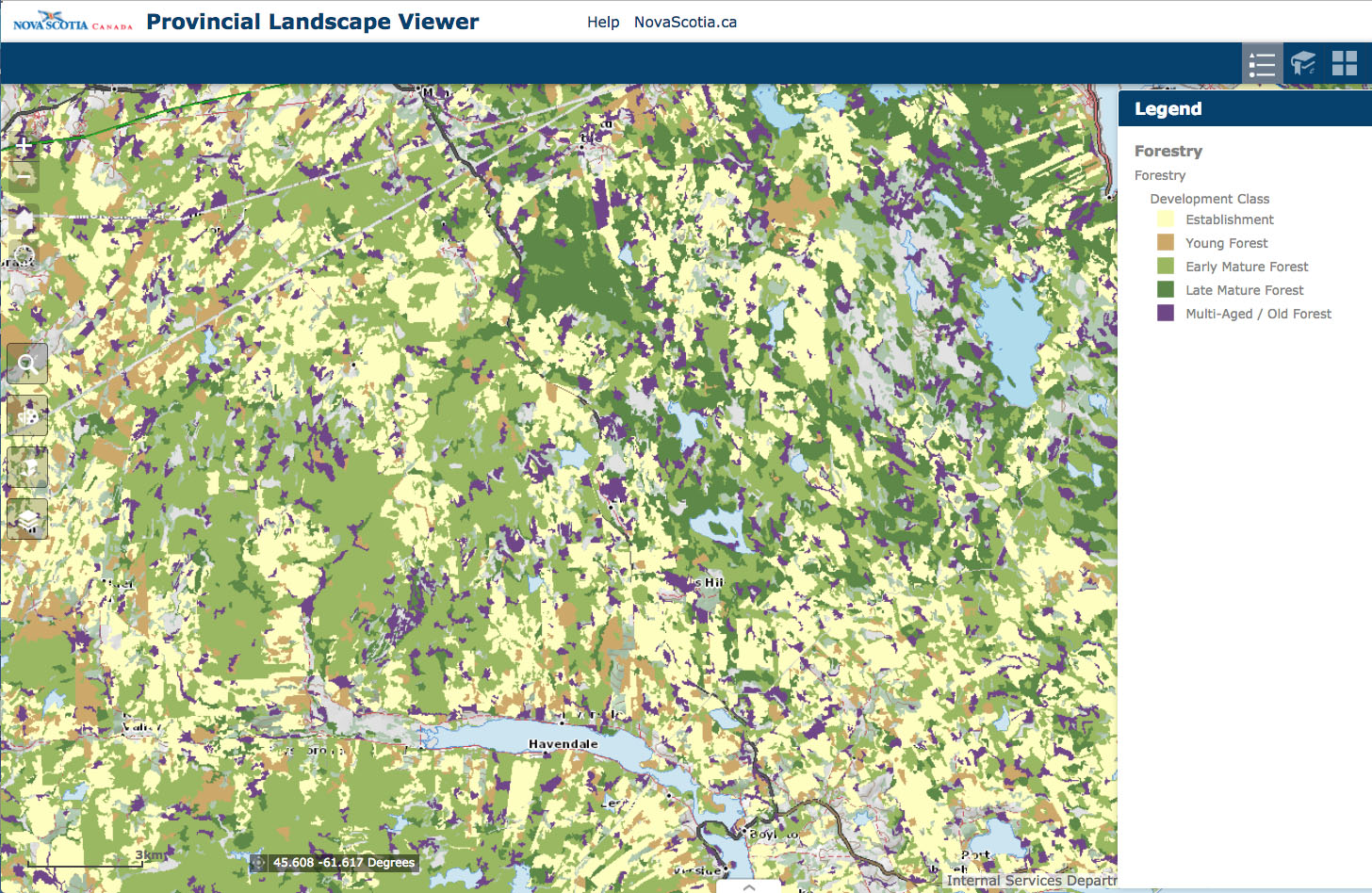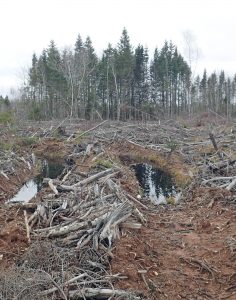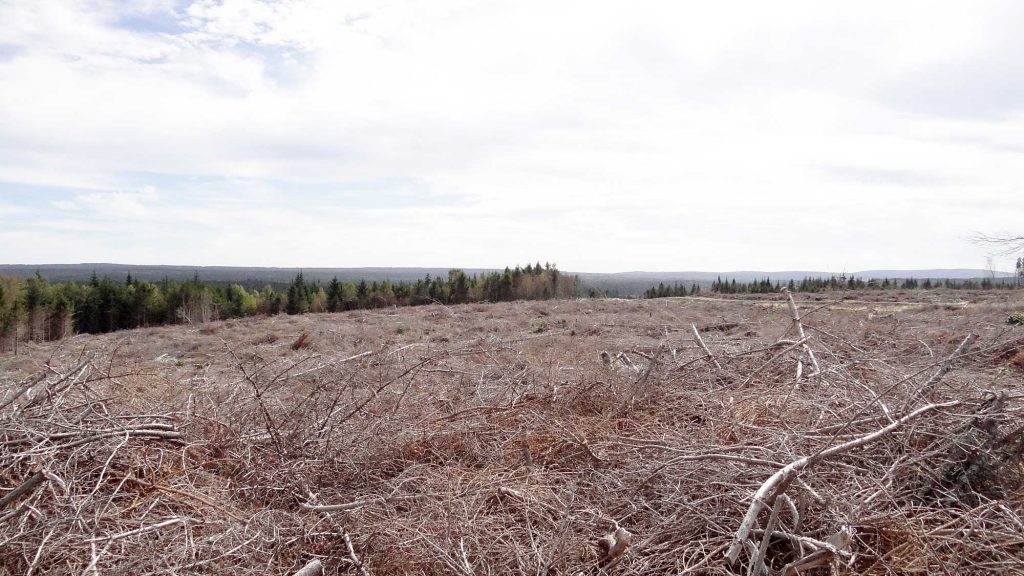“Now that it has been made abundantly clear that the forestry industry lobby will never allow any new biodiversity regulations on private lands, it is equally clear that our Crown lands are the only option we have, as a province, to meet our obligation to protect and restore biodiversity.”
Text received from Raymond Plourde, Senior Wilderness Coordinator at Ecology Action Centre, published on Saltwire, May 26, 2021 (RAYMOND PLOURDE: Time for industrial forestry to vacate Crown lands):
In the aftermath of the great Biodiversity Act debacle, one thing has been made exceedingly clear: the forestry industry lobby group, Forest Nova Scotia, will never allow any kind of new government regulations to protect biodiversity on private lands in Nova Scotia. In fact, it will go to extraordinary lengths to prevent it.
This includes spending a small fortune (as much as a quarter million dollars by some estimates) to viciously attack the government’s Biodiversity Act. Forest Nova Scotia’s massive advertising campaign, run in newspapers and on radio stations across the province, was a well-orchestrated smear campaign of both the act and nefarious “Halifax activists” bent on “harassing landowners and stopping all agriculture, recreational activity, forestry, home building, hunting and fishing on private lands.”
It was so over the top that it would be laughable if it weren’t so deliberately misleading. Some rural landowners were whipped up into a frenzy and pitted against urban citizens based on a campaign of fear and lies. Make no mistake, small private landowners were deliberately used by the big industry players to achieve their political endgame: gutting the act.
And environmental groups were used as the scary boogeyman in the same way that scary “illegal immigrants” or “liberal elites” are used to stoke fear and pushback in the U.S.
It was, in a word, deplorable. In doing what they did, Forest Nova Scotia have essentially forfeited any claim of legitimacy as a responsible partner of or adviser to government on matters relating to responsible forestry practices and public land management.
So what was Forest Nova Scotia’s expensive, misleading PR campaign against the Biodiversity Act really all about? What is it they’re so afraid of that they would go to such lengths and depths?
Old trees support biodiversity and store carbon. Raymond Plourde spotted this old, wind-twisted red maple during a hike through Old Forest by Sandy Lake (Bedford, N.S.) on Sep 15, 2019. When such trees – not usable for lumber – are harvested in clearcuts, we lose old forest biodiversity. Typically they are chipped for burning, instantly releasing all of the tree’s stored carbon as atmospheric carbon dioxide and contributing to global warming. (NSFN photo)
Well, beyond a tacit acknowledgment that they know, deep down, that their industrial harvesting practices do harm biodiversity, it’s the same thing it’s always been about: clearcutting. It’s about making sure no new legislation or regulations that might limit clearcutting and herbicide spraying on private lands are ever enacted.
The big forestry companies behind Forest Nova Scotia are the largest private landowners in the province by far. Their lands are what are called “industrial freehold” lands, which together make up roughly 20 per cent of the provincial landmass. There’s no way they were willing to tolerate even the possibility of new regulations that might curtail their industrial tree-farming practices — clearcut, plant, spray, thin, repeat — especially on their own large industrial freehold lands. Keeping small private woodlots open to clearcutting was just a bonus.
Despite hundreds of standout, conscientious woodlot owners across the province who tend their forest lands very well, many still do not. The Lahey report confirms that clearcutting is still in the range of 90 per cent of all harvests on private lands. That’s what this was really all about. It sure wasn’t about farming, snowshoeing, bird watching, fly fishing or any other activity as claimed in their attack ads. It was about making sure nothing gets in the way of clearcutting and spraying on private lands, including and especially large industrial freehold lands.
So where do we go from here?
Well, given that the forestry industry lobby will not tolerate any new regulations on private lands; and given that the biodiversity crisis is real and accelerating; and given that Canada, along with virtually every other nation in the world, has signed international treaties committing to protect 30 per cent of our land and water by 2030; and given that public Crown lands, the only place where biodiversity regulations will apply, make up just 30 per cent of Nova Scotia’s landmass, it is therefore obvious that the public Crown lands will need to carry most of the load for biodiversity conservation in Nova Scotia moving forward.

Extensive clearcutting over much of NS – which is 75% forested, down from probably >90% in pre-Columbian times – has ensured survival of early successional forest species but has come at the expense of old forest species and of species requiring large areas of intact forest. It has also reduced carbon storage in the trees and in the soil, thereby contributing to global warming. It also alters hydrological regimes and reduces other ‘Ecological Services‘. (NSFN Screen Capture from Provincial Landscape Viewer)
This means that the government will have to protect the vast majority of public Crown lands for conservation and recreation and other low-impact uses. Industrial forestry will have to withdraw from public Crown lands and focus their efforts on the unregulated private lands that make up 70 per cent of the province.
This might not be so bad. It would be an excellent opportunity to scale-up Prof. William Lahey’s recommended “Triad System for Ecological Forestry” whereby the forested landmass is divided into three distinct zones or “legs.” One leg for protection, one for high-production tree-growing and one that allows low-impact harvesting in an “ecological matrix” where the overarching management objective is ecosystem health.
Instead of applying this system just to Crown lands — which only total 30 per cent of the landmass — we could scale the Triad system up to the whole forested landmass of the province. Crown lands would carry the protected leg at 30 per cent; the intensive forestry management (plantation) leg would take place on unregulated private lands, including both large industrial freehold lands and small woodlots where owners wish to practice this kind of management; and the matrix leg of the triad would take place on the many small private woodlots where owners wish to practice the “ecological forestry” style of management.
The industry bigwigs will undoubtedly howl at this suggestion. They will quickly assert that no, they must have it all. Because that is what they’ve always had: access to publicly owned Crown lands as well as the unregulated private lands.
But times are changing and priorities are changing. That position is no longer tenable, if it ever was. Who ever said that public Crown lands should primarily be the domain of industrial forestry? Now that it has been made abundantly clear that the forestry industry lobby will never allow any new biodiversity regulations on private lands, it is equally clear that our Crown lands are the only option we have, as a province, to meet our obligation to protect and restore biodiversity.
Related Post
Plourde urges Premier to reset the agenda on nature for Nova Scotia 13Oct2020



